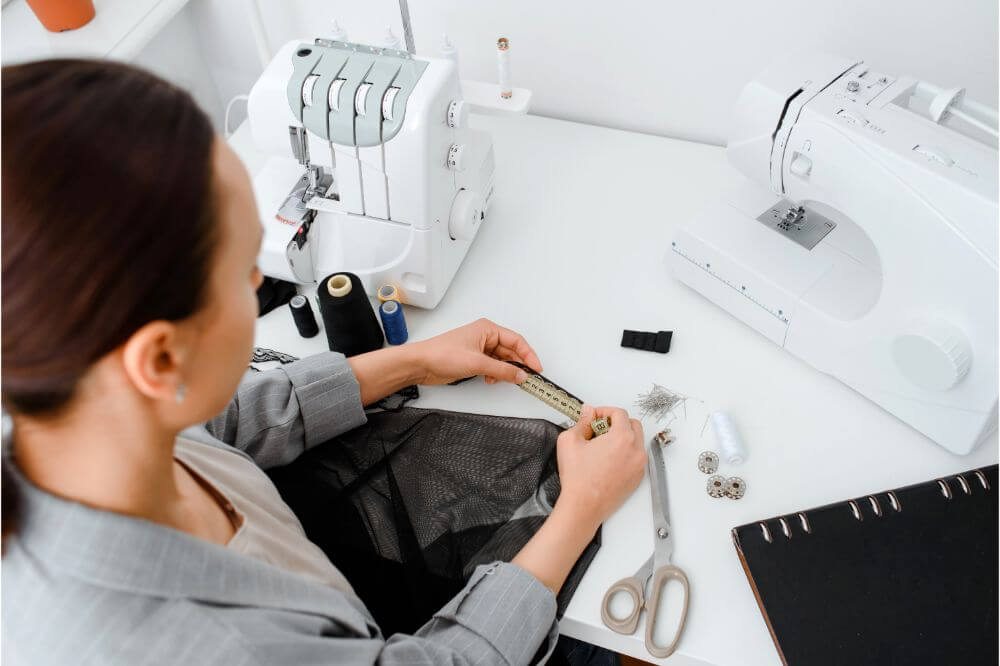If you are planning on sewing, serging, stitching, and making seams, there are a few tools that you may have used for. Yes, of course the regular sewing machine is very versatile and can be used for number purposes. However, there are things that normal sewing machines just can’t do.
This is especially the case when you compare them to overlocker machines, also known as serger machines, as well as coverstitch machines. Now, the issue here is that many people confuse serger machines with coverstitch machines.
Yes, both overlocker or serger machines as well as cover stitch machines have many similarities, but there are also a few things that make them quite different. Moreover, keep in mind that neither of these machines can effectively replace a normal sewing machine.
Yet, both overlockers and coverstitch machines have features that make them worthwhile. Let’s figure out exactly what both are and what makes them different. This Overlocker/Serger vs Coverstitch machine comparison will tell you exactly what both machines are best used for.
What is a Serger?
First, we have the serger machine, also known as an overlocker. These are designed to create professional and clean finishes on sleeves, hems, seems, and other tailored items. This is done by trimming away the seam allowances and also encasing the raw edges of the seams in a single smooth operation.
Most also come complete with knives designed to cut away the excess seam allowance. Therefore, with a serger machine, in one simple step, you can create seems, close those seams, and then also trim away the excess seam allowance. The vast majority of serger machines are designed to work best with knitted fabrics, and they produce extremely professional results with multiple fabric layers.
They can generally also handle both lightweight and heavy fabrics. Generally speaking, these are going to take anywhere between three to eight cones of thread, with most taking either three or four, or sometimes five. They usually also come with two needles and may operate at up to 1700 stitches every minute.
What is a Coverstitch Machine?
Once again you, do not confuse a coverstitch machine for a sergeror overlocker, because they’re just not the same things. Generally speaking, a coverstitch machine is specifically designed to create professional finishes on hems. This is especially the case on knit fabrics.
Now, this is really the one and only purpose of a cover stitch machine. It’s all about creating stretchable, secure, and even seams that can move along with the fabric in question.
You can also use these machines to attach elastic, other trims, and lace to any sewing project or any garment in question. These machines may also be able to produce some really nice and decorative stitching effects.
Overlocker/Serger vs Coverstitch Machine
Let’s now take a look at the main similarities shared by these two machines, as well as the main differences between them.
Similarities
Let’s first figure out what makes the serger machines and coverstich machines similar to each other.
- One of the main similarities is that both machines are best used with very fine and strong threads in combination with slick and smooth surfaces.
- For most serger and coverstitch machines, the needles generally are not universal. You have to use very specific needles for specific machines, and for specific purposes.
- Both of these tools allow you to adjust the differential feed using a control dial.
- Many of these machines also come complete with free arms that allow you to work on smaller areas and on sleeves.
- Many models also come complete with a highly adjustable pressure foot to allow for thick fabrics and multiple layers of fabric to be worked on.
Differences
Now that we know what makes these two things similar, let’s figure out what makes them different.
- A coverstitch machine does also have the ability to sew fabrics just like a regular sewing machine. Although it will create a dual line of stitches that produces a visible finish.
- Overlocker machines have the main purpose of serging together the edges of fabrics while also trimming them. Coverstitch machines on the other hand generally do not have blades that cut excess fabric.
- Serger machines generally have much less space in between the machine housing and the right hand needle.
- Coverstitch machines generally feature much larger work in areas.
- Serger machines always have two looper threads, whereas coverstitch machines generally only have one.
- A coverstitch machine usually always has three needles, whereas most serger machines only have two. However, much newer serger machines may provide you the option to use up to three or even four needles.
- Serger or overlocker machines always come complete with a set of dual cutting knives that trim fabric edges as you create stitches. Coverstitch machines do not have.
Conclusion
Which of these machines you get is of course up to you. With that being said, if you are looking to produce very secure and strong edge finishes, hems, seems, and decorative stitches, then it is a serger machine that you need. This is especially the case if you want to work at a high rate of speed. Of course, the benefit is that these machines also cut fabric as you search.
However, if you are looking to create professional grade ends that are really extravagant and good looking, then a coverstitch machine is ideal. When it comes to a cove stitch machine, you can also replace this with a good embroidery machine or a double needle sewing machine that has many different stitching options.

